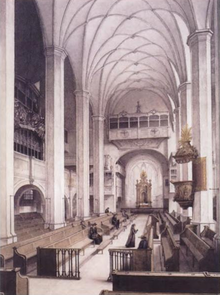Halt im Gedächtnis Jesum Christ, BWV 67
| Halt im Gedächtnis Jesum Christ | |
|---|---|
| BWV 67 | |
| Church cantata by J. S. Bach | |

Thomaskirche, Leipzig
|
|
| Occasion | Sunday after Easter |
| Performed | 16 April 1724: Leipzig |
| Movements | 7 |
| Cantata text | anonymous |
| Bible text | |
| Chorale |
|
| Vocal | |
| Instrumental |
|
Halt im Gedächtnis Jesum Christ (Keep Jesus Christ in mind),BWV 67, is a church cantata by Johann Sebastian Bach. He composed it in Leipzig for Quasimodogeniti, the first Sunday after Easter, and first performed it on 16 April 1724.
Based on the prescribed gospel of the appearance of Jesus to the Disciples, first without then with Thomas, an unknown poet compares the situation of the doubtful Thomas to the Christian in general. He places Nikolaus Herman's Easter hymn "Erschienen ist der herrlich Tag" in the centre of the cantata, repeats the line "Friede sei mit euch" (Peace be with you) several times, and ends with the first stanza from Jakob Ebert's hymn "Du Friedefürst, Herr Jesu Christ" (Thou Prince of Peace, Lord Jesus Christ). Bach structured the work in seven movements, arranged in symmetry around the central chorale, and scored it for three solo voices, a four-part choir and a Baroque instrumental ensemble of a slide horn for hymn tunes, flauto traverso, two oboes d'amore, strings and basso continuo. Besides the unusual central chorale, the cantata contains a dramatic scenem with Jesus repeating "Peace be with you" against the enemies.
Bach composed the cantata in his first year as Thomaskantor in Leipzig, shortly after he first performed his St John Passion, for the First Sunday after Easter, called Quasimodogeniti. The prescribed readings for that Sunday were from the First Epistle of John, "our faith is the victory" (), and from the Gospel of John, the appearance of Jesus to the Disciples, first without then with Thomas, in Jerusalem (). The unknown poet begins with a verse from the Second Epistle to Timothy, "Remember that Jesus Christ … was raised from the dead" (). The poet sees Thomas as similar to the doubtful Christian in general, whose heart is not at peace. The center of the cantata is the Easter hymn "Erschienen ist der herrlich Tag" (The glorious day has appeared) by Nikolaus Herman (1560), praising the day of the resurrection. In contrast, movement 5 recalls the danger by the enemies, until in movement 6 Jesus appears, as he did to his disciples in Jerusalem, finally bringing peace. The line "Friede sei mit euch" (Peace be with you) is repeated four times, framing three stanzas of a poem. The closing chorale is the first stanza of "Du Friedefürst, Herr Jesu Christ" (Thou Prince of Peace, Lord Jesus Christ) by Jakob Ebert (1601).
...
Wikipedia
